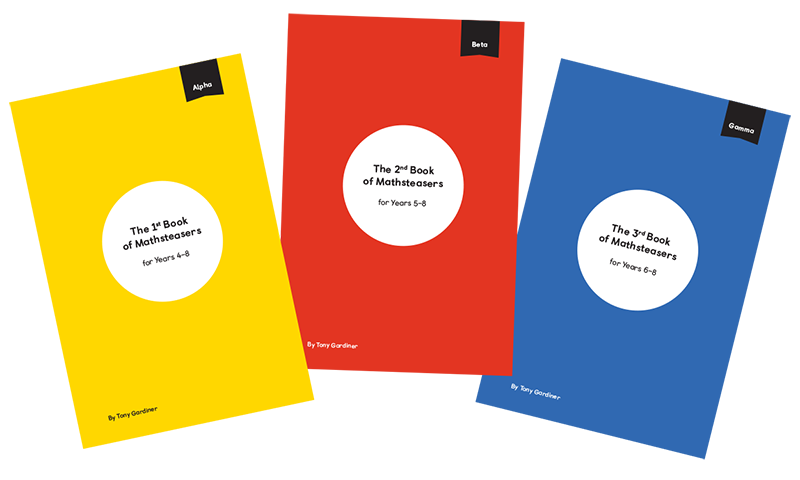Getting the most out of Mathsteasers
Our school has used the Mathsteasers series over the last two terms in Years 4, 5 and 6. There were no stipulations when we started, only that Mathsteasers were an extra resource which should, ideally, be used by all rather than just by advanced learners. Our experience has been really positive and I’d like to share some of my observations about how to get the most out of the series:
One Rule
The golden rule for tackling these challenges is for pupils to work with a partner or within a small group. My son in Year 5 said, when asked, “you won’t be able to do all the questions straight off, you need a partner to look at the questions in a different angle to you”. Although a keen playground footballer, he did actually stay inside one breaktime in order to complete a series of questions on simplifying fractions and converting them to decimals.
His class used them as extension work towards the end of a lesson on completion of the workbook. With some lessons in the workbook being a single page, this allowed all pupils to tackle some questions rather than it being the preserve of the fastest. Pupils teamed back up with those they had worked with during the anchor task and guided practice. Answers and ideas were then shared with the whole class.
Mathsteaser Pick ‘n’ Mix
As a teacher I begin by highlighting particular problems for the pupils to tackle. For instance, in Year 6, there are a number of lessons on addition and subtraction of fractions so those questions were taken and put onto a word document and partners selected which grade of problem they wanted to tackle. It showed the change of mindset with the pupils. On our old style of maths, the quest for the right answer would have been of paramount importance. This would have led to frustration and disengagement for many.
Now the children thrived on the fact that their thinking sometimes took them the wrong way or led them to an answer they knew instinctively was wrong. The level of talk in the classroom went up another notch as the pupils got deeper into the problems. Methods were shared and, when it really worked, groups moved to different areas of the class to see what others were doing and help each other out.
Boost Your Practice with FREE CPD
Receive a CPD boost every time you refer a school! Both you and the referred school will earn a full day of CPD and 2 free places on our 3-day Essentials of Teaching Maths Mastery course (valued at £1700).
Get started on helping struggling schools reach maths success now!

Mathsteaser Workouts
As a variation to the Mind Workout, we also used Mathsteasers as a whole class session on the completion of a chapter. Initially, our pupils worked through the problems before adopting more of a pick ‘n’ mix style as detailed above. The grading of the problems is good but you need to guide the pupils here in order to prevent those that leap straight into the three star problems and get bogged down. Even with a threestar grading system, there is a level of variation within each star. In effect, pupils may find some one star problems easy to tackle but others in the same banding might prove tricky. Although the answers are in the back of the booklet, it is essential that teachers consider the possible methods the pupils might employ as the journey to the answers generates all the discussion and the thinking.
Mathsteaser Journaling
The challenging nature of the questions in the booklet make it an ideal forum for exploring further in journaling. Teachers want to see that each topic is grasped sufficiently richly with the layers of variation and subtlety being like an onion. Allowing the pupils to take one or two answers for a descriptive journal piece where they write or draw their thinking shows this variation and flexibility in their thinking. Maths Mastery is about bringing everyone along together; exploring one tricky problem allows an exploration of one of those onion layers. If time didn’t allow for this in lessons – and, to be honest, that was more often than not – then it was useful as a piece of homework. Parents could also understand that maths problems involved this idea of relational understanding.
Mathsteasers author Tony Gardiner talked in the MNP 2017 conference about “those who might one day want to build higher must first dig deeper foundations, on which later ideas can sit”. Blending the thinking of Mathsteaser problems with the thinking in a journal marries this idea really well.
Make Mathsteasers part of your lesson
As a school, we will certainly be using the Mathsteaser series next academic year. With the above approaches as a starting point, we were able to use them for all learners which was important. Pupils enjoyed the challenges and struggle and recognised that the journey to the answer relied on flexibility of thinking. It also impresses on pupils the idea that working together is the maths that works best. Place them within the weekly context of your maths lessons and I’m sure your pupils will get a lot from them.
Give advanced learners the struggle they need with Mathsteasers: a three-part booklet series developed by MNP and Tony Gardiner.

